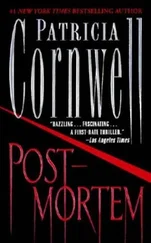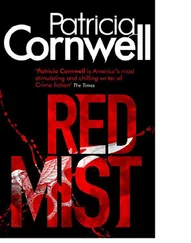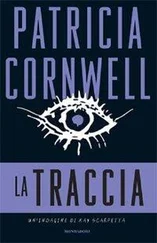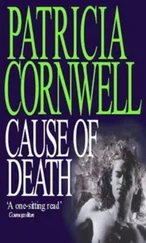Patricia Cornwell - Postmortem
Здесь есть возможность читать онлайн «Patricia Cornwell - Postmortem» весь текст электронной книги совершенно бесплатно (целиком полную версию без сокращений). В некоторых случаях можно слушать аудио, скачать через торрент в формате fb2 и присутствует краткое содержание. Жанр: Фантастика и фэнтези, на английском языке. Описание произведения, (предисловие) а так же отзывы посетителей доступны на портале библиотеки ЛибКат.
- Название:Postmortem
- Автор:
- Жанр:
- Год:неизвестен
- ISBN:нет данных
- Рейтинг книги:3 / 5. Голосов: 1
-
Избранное:Добавить в избранное
- Отзывы:
-
Ваша оценка:
- 60
- 1
- 2
- 3
- 4
- 5
Postmortem: краткое содержание, описание и аннотация
Предлагаем к чтению аннотацию, описание, краткое содержание или предисловие (зависит от того, что написал сам автор книги «Postmortem»). Если вы не нашли необходимую информацию о книге — напишите в комментариях, мы постараемся отыскать её.
Postmortem — читать онлайн бесплатно полную книгу (весь текст) целиком
Ниже представлен текст книги, разбитый по страницам. Система сохранения места последней прочитанной страницы, позволяет с удобством читать онлайн бесплатно книгу «Postmortem», без необходимости каждый раз заново искать на чём Вы остановились. Поставьте закладку, и сможете в любой момент перейти на страницу, на которой закончили чтение.
Интервал:
Закладка:
Rubbing a dollop of the lotion on his hands, Vander pulled on a pair of white cotton gloves. The acetone, xylene and constant hand-washing that go with his trade were brutal on his skin, and I could always tell when he'd forgotten to put on gloves while using ninhydrin, a chemical helpful for visualizing latent prints, because he'd walk around with purple fingers for a week. His morning ritual complete, he motioned me to follow him out into the fourth-floor hallway.
Several doors down was the computer room, clean, almost sterile, and filled with light-silver modular hardware of various boxy shapes and sizes, bringing to mind a space-age Laundromat. The sleek, upright unit most closely resembling a set of washers and dryers was the fingerprint matching processor, its function to match unknown prints against the multimillion fingerprint data base stored on magnetic disks. The FMP, as it was known, with its advanced pipeline and parallel processing was capable of eight hundred matches per second. Vander didn't like to sit around and wait for the results. It was his habit to let the thing cook overnight so he had something to look forward to when he came to work the next morning.
The most time-consuming part of the process was what Vander did Saturday, feeding the prints into the computer. This required his taking photographs of the latent prints in question, enlarging them five times, placing a sheet of tracing paper over each photograph and with a felt-tip pen tracing the most significant characteristics. Next he reduced the drawing to a one-to-one-sized photograph, precisely correlating to the actual size of the print. He glued the photograph to a latent-print layout sheet, which he fed into the computer. Now it simply was a matter of printing out the results of the search.
Vander seated himself with the deliberation of a concert pianist about to perform. I almost expected him to flip up his lab coat in back and stretch his fingers. His Steinway was the remote input station, consisting of a keyboard, a monitor, an image scanner and a fingerprint image processor, among other things. The image scanner was capable of reading both ten-print cards and latent prints. The fingerprint image processor (or FIP, as Vander referred to it) automatically detected fingerprint characteristics.
I watched him type in several commands. Then he punched the print button, and lists of potential suspects were rapidly hammered across the green-striped paper.
I pulled up a chair as Vander tore off the printout and ripped the paper into ten sections, separating his cases.
We were interested in 88-01651, the identification number for the latents found on Lori Petersen's body. Computerized print comparison is analogous to a political election. Possible matches are called candidates, and ranked according to score. The higher the score, the more points of comparison a candidate has in common with the unknown latents entered into the computer. In the case of 88-01651 there was one candidate leading by a wide margin of more than one thousand points. This could mean only one thing.
A hit.
Or as Vander glibly put it, "A hot one."
The winning candidate was impersonally listed as NIC112.
I really hadn't expected this.
"So whoever left the prints on her has prints on file with the data base?" I asked.
"That's right."
"Meaning it's possible he has a criminal record?"
"Possible, but not necessarily."
Vander got up and moved to the verification terminal. He lightly rested his fingers on the keyboard and stared into the CRT display.
He added, "Could be he was printed for some other reason. If he's in law enforcement, or maybe applied for a taxi license once."
He began calling up fingerprint cards from the depths of image retrieval. Instantly, the search-print image, an enlarged aggregation of loops and whorls in turquoise blue, was juxtaposed to the candidate-print image. To the right was a column listing the sex, race, date of birth and other information revealing the can didate's identification. Producing a hard copy of the prints, he handed it over.
I studied it, read and reread the identity of NIC112.
Marino would be thrilled.
According to the computer, and there could be no mistake about it, the latents the laser picked up on Lori Petersen's shoulder were left by Matt Petersen, her husband.
Chapter 4
I was not unduly surprised that Matt Petersen touched her body. Often it is a reflex to touch someone who appears dead, to feel for a pulse or to grip a shoulder lightly the way one does to wake up the person. What dismayed me were two things. First, the latents were picked up because the individual who left them had a residue of the perplexing sparkles on his fingers - evidence also found in the previous strangling cases. Second, Matt Petersen's ten-print card had not been turned in to the lab yet. The only reason the computer got a hit was he already had prints on file with the data base.
I was telling Vander we needed to find out why and when Petersen was printed in the past, if he had a criminal record, when Marino walked in.
"Your secretary said you was up here," he announced by way of a greeting.
He was eating a doughnut I recognized as having come from the box by the coffee machine downstairs. Rose always brought in doughnuts on Monday mornings. Glancing around at the hardware, he casually shoved a manila envelope my way. "Sorry, Neils," he mumbled. "But the Doc here says she's got first dibs."
Vander looked curiously at me as I opened the envelope. Inside was a plastic evidence bag containing Petersen's tenprint card. Marino had put me on the spot, and I didn't appreciate it. The card, under ordinary circumstances, should have been receipted directly to the fingerprints lab - not to me. It is this very sort of maneuver that creates animosity on the part of one's colleagues.
They assume you're violating their turf, assume you're preempting them when, in truth, you may be doing nothing of the sort.
I explained to Vander, "I didn't want this left on your desk, out in the open where it might be handled. Matt Petersen supposedly was using greasepaint before he came home. If there was a residue on his hands, it may also be on his card."
Vander's eyes widened. The thought appealed to him. "Sure. We'll run it under the laser."
Marino was staring sullenly at me.
I asked him, "What about the survival knife?"
He produced another envelope from the stack wedged between his elbow and waist.
"Was on my way to take it to Frank." Vander suggested, "We'll take a look at it with the laser first."
Then he printed out another hard copy of NIC 112, the latents that Matt Petersen had left on his wife's body, and presented it to Marino.
He studied it briefly, muttering, "Ho-ly shit," and he looked up straight at me.
His eyes smiled in triumph. I was familiar with the look, which I had expected. It said, "So there, Ms. Chief: So maybe you got book-learning, but me, I know the street."
I could feel the investigative screws tightening on the husband of a woman who I still believed was slain by a man not known to any of us.
Fifteen minutes later, Vander, Marino and I were inside what was the equivalent of a darkroom adjoining the fingerprint lab. On a countertop near a large sink were the ten-print card and the survival knife. The room was pitch-black. Marino's big belly was unpleasantly brushing my left elbow as the dazzling pulses ignited a scattering of sparkles on the inky smudges of the card. In addition, there were sparkles on the handle of the knife, which was hard rubber and too coarse for prints.
On the knife's wide shiny blade was a smattering of virtually microscopic debris and several distinct partial prints that Vander dusted and lifted. He leaned closer to the ten-print card. A quick visual comparison with his eagle, expert eye was enough for him to tentatively say, "Based on an initial ridge comparison, they're his, the prints on the blade are Petersen's."
Читать дальшеИнтервал:
Закладка:
Похожие книги на «Postmortem»
Представляем Вашему вниманию похожие книги на «Postmortem» списком для выбора. Мы отобрали схожую по названию и смыслу литературу в надежде предоставить читателям больше вариантов отыскать новые, интересные, ещё непрочитанные произведения.
Обсуждение, отзывы о книге «Postmortem» и просто собственные мнения читателей. Оставьте ваши комментарии, напишите, что Вы думаете о произведении, его смысле или главных героях. Укажите что конкретно понравилось, а что нет, и почему Вы так считаете.












